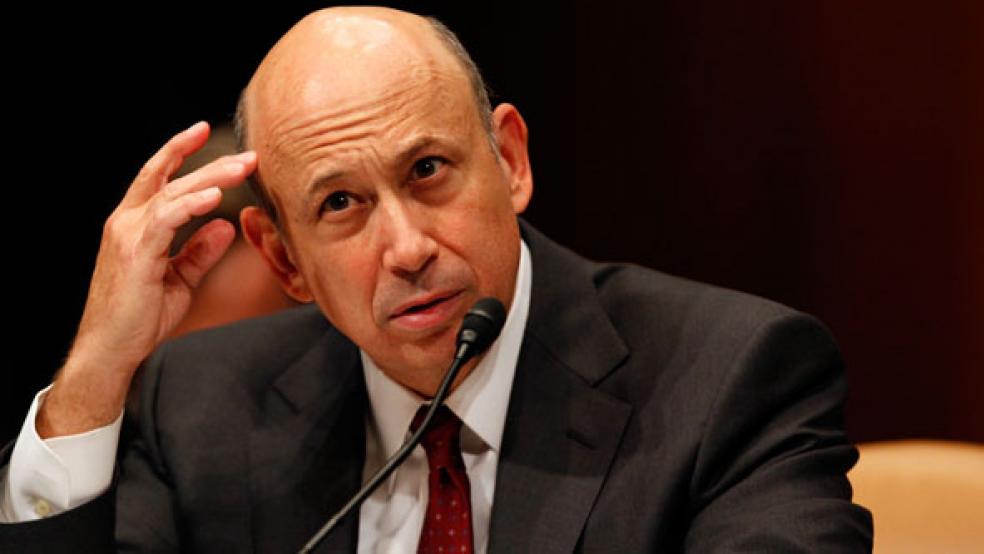One by one, the country’s largest financial institutions are reporting their third-quarter earnings, and in some cases, they are turning out to be much better than analysts had expected.

Consider JP Morgan Chase, for a moment. The London Whale’s trading losses could have negatively affected the bank’s financial performance – but the bank had the most profitable quarter on record, up 34 percent from year-earlier levels. While investment banking’s profits were down very modestly, the volume of dealmaking soared: JP Morgan’s clients rushed to take advantage of rock-bottom interest rates and refinance their debt, triggering a 62 percent jump in underwriting fees; overall, investment banking fees climbed 38 percent over 2011 levels.
Today's news from Goldman Sachs: the bank posted better-than-expected earnings. As Thomson Reuters analyst John Kozey points out, at the beginning of September, the consensus was that Goldman would earn only about $2 a share for the third quarter; by yesterday, that stood at $2.12. Today's surprise -- investors are rewarded with a blowout $2.85 a share.
That would certainly be good news for Goldman, bracing for the release next week of the book by its former banker Greg Smith, who memorably submitted his resignation letter to the op-ed column of The New York Times early this year. Entitled, rather unimaginatively, “Why I Left Goldman Sachs,” the closely guarded manuscript is expected to contain all kinds of revelations about how Goldman’s bankers referred to their clients as “muppets.”
In an effort to discredit the book, Goldman did its own investigation and found no evidence of a “muppet” scandal. (Not even a mention of Big Bird!) If only from a PR perspective, it would be great for Goldman Sachs to be able to distract investors by pointing to what really counts – substantive earnings and signs of renewed growth in the financial services sector.
The big news at Citigroup is the resignation of Chief Executive Vikram Pandit, who will be replaced by Michael Corbat. Corbat was head of Europe, the Middle East and Africa. John P. Havens, president and COO, also resigned. They are leaving even as Citigroup did better than expected, announcing earnings of $1.06 a share, 7 cents better than the analysts’ consensus. Morningstar pointed out that the stock continues to trade at a hefty discount to fair value and tangible book, meaning that there’s room for an improved earnings performance to help trigger – at last – a higher dividend or share repurchases. Meanwhile, the banking analysts at Keefe, Bruyette & Woods are even taking a more upbeat view of the outlook for Bank of America, based on the insight into investment banking, mortgage banking and consumer credit provided by JP Morgan’s results.
But…to go with this shiny silver lining, there has to be a cloud. And the cloud comes in the shape not of earnings, but of another financial metric altogether: ROE, or return on equity. And even as earnings are recovering, the ROE – a measure of how well the banks are doing at investing the capital entrusted to them by shareholders and generating a profit on that capital – remains underwhelming at best, dismal at worst. To hang on to its investors, a bank needs to generate a ROE that is in excess of its cost of capital – something most of them have failed to do in recent quarters. (Wells Fargo is one exception to this rule.)
A bare minimum ROE is viewed as about 10 percent, the rough median cost of capital for most banks. At Goldman Sachs, a level of 20 percent used to be viewed as the minimum acceptable ROE; last month, the bank made headlines Sandler O’Neill analyst Jeff Harte reported that Goldman execs believed that the 20 percent figure was once more a reasonable target.
Once, that looked easy – in the pre-crisis period, the ROE hovered north of 20 percent and occasionally even ventured above 30 percent. It has been in steady freefall since the end of the crisis, plunging from 23.76 percent in early 2010 to a low of just north of 3 percent late last year, recovering slightly to 5.2 percent in the second quarter.
Goldman Sachs is hardly alone in its pursuit of more acceptable ROE figures. A recent study by McKinsey & Co. pointed out that the average ROE of the world’s 300 largest lending institutions was a depressing 7.6 percent in 2011; U.S. banks fared even worse, earning only 7 percent. Toos Daruvala, a McKinsey director, told Reuters that almost two-thirds of U.S. banks today earn less than their cost of capital and that investors in most of them will have to wait another three to five years for that ROE to recover to an acceptable level.
Whether or not it’s reasonable to expect ROE levels to be higher in a rather unique post-crisis environment, characterized by new regulations and capital rules as well as rock bottom interest rates is another question altogether. But since when were investors’ expectations ever dignified by the label, “reasonable”? That’s why there has been so much attention to the McKinsey’s report, and its prescription for higher ROEs, which include massive cost-cutting and a technological revolution of sorts.
What worries some of Wall Street’s more critical observers is that these institutions may choose to try to hit their ROE targets by finding creative new ways to ratchet up leverage or take on risk. Sound worrying? It should. We may be heading toward a fresh confrontation between regulators and policymakers who heed comments like those made by former FDIC chair Sheila Bair in her new book and in recent public comments calling for a still higher cost of capital, and banks that are under pressure not just to generate a positive earnings surprise once a quarter but reward investors with a steadily improving return on equity. The latter is going to make delivering good earnings news look like an afternoon stroll in the park.






